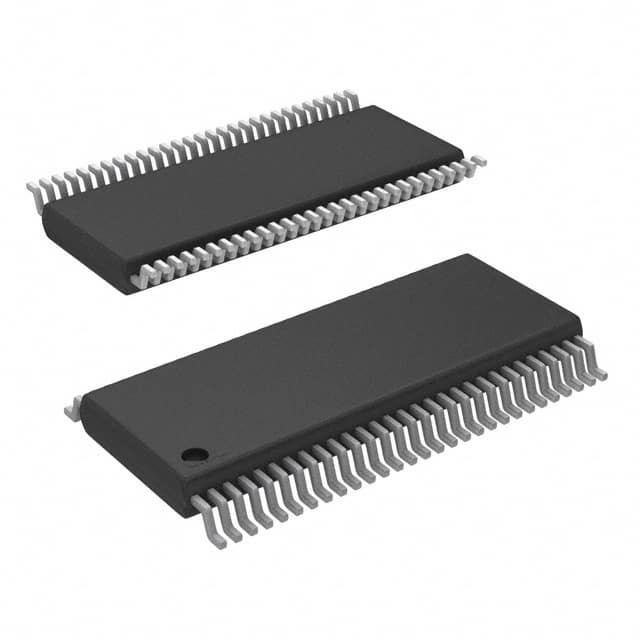SN74ALVCH16646DGVR
Basic Information Overview
- Category: Integrated Circuit (IC)
- Use: Bus Transceiver
- Characteristics:
- High-speed, low-voltage CMOS technology
- Wide voltage range operation (1.2V to 3.6V)
- Bidirectional data flow capability
- 16-bit wide transceiver with 3-state outputs
- Package: VSSOP (Very Small Outline Package)
- Essence: Transceiver IC for bidirectional data transfer
- Packaging/Quantity: Tape and Reel, 2500 units per reel
Specifications
- Supply Voltage Range: 1.2V to 3.6V
- Input Voltage Range: 0V to VCC
- Output Voltage Range: 0V to VCC
- Operating Temperature Range: -40°C to +85°C
- Maximum Data Rate: 400 Mbps
Detailed Pin Configuration
The SN74ALVCH16646DGVR has a total of 48 pins. The pin configuration is as follows:
___________
| |
1A1 |1 48| VCC
1Y1 |2 47| 2A1
2Y1 |3 46| 2A2
1A2 |4 45| 2Y2
1Y2 |5 44| 2Y1
2Y2 |6 43| 1Y1
1A3 |7 42| 1A1
1Y3 |8 41| GND
2Y3 |9 40| 2A3
1A4 |10 39| 2Y3
1Y4 |11 38| 2Y4
2Y4 |12 37| 1Y4
1A5 |13 36| 1A4
1Y5 |14 35| GND
2Y5 |15 34| 2A5
1A6 |16 33| 2Y5
1Y6 |17 32| 2Y6
2Y6 |18 31| 1Y6
1A7 |19 30| 1A6
1Y7 |20 29| GND
2Y7 |21 28| 2A7
1A8 |22 27| 2Y7
1Y8 |23 26| 2Y8
2Y8 |24 25| 1Y8
|___________|
Functional Features
- Bidirectional data flow: Allows data to be transmitted and received on the same pins.
- 3-state outputs: Enables the outputs to be in a high-impedance state when not actively transmitting or receiving data.
- Wide voltage range operation: Supports operation from 1.2V to 3.6V, making it compatible with various systems.
Advantages and Disadvantages
Advantages: - High-speed operation - Low-voltage operation - Bidirectional data flow capability - Compact VSSOP package
Disadvantages: - Limited maximum data rate compared to some other bus transceivers - Not suitable for applications requiring higher voltage levels
Working Principles
The SN74ALVCH16646DGVR is a bus transceiver that facilitates bidirectional data transfer between two buses. It operates using high-speed, low-voltage CMOS technology. The device has 16-bit wide transceivers with 3-state outputs, allowing data to flow in both directions. When not actively transmitting or receiving data, the outputs can be put into a high-impedance state.
Detailed Application Field Plans
The SN74ALVCH16646DGVR is commonly used in various applications, including: - Data communication systems - Networking equipment - Industrial automation - Automotive electronics - Consumer electronics
Detailed and Complete Alternative Models
Some alternative models that can be considered as alternatives to the SN74ALVCH16646DGVR are: - SN74LVC16646A: Similar functionality with a wider voltage range (1.65V to 5.5V) - SN74LVTH16646: Higher maximum data rate (500 Mbps) but operates at a higher voltage range (2.7V to 3.6V) - SN74AVC16646: Supports higher voltage levels (up to 5
قم بإدراج 10 أسئلة وإجابات شائعة تتعلق بتطبيق SN74ALVCH16646DGVR في الحلول التقنية
Sure! Here are 10 common questions and answers related to the application of SN74ALVCH16646DGVR:
Q: What is SN74ALVCH16646DGVR? A: SN74ALVCH16646DGVR is a 16-bit bus transceiver with 3-state outputs, designed for low-voltage (1.65V to 3.6V) applications.
Q: What is the purpose of SN74ALVCH16646DGVR? A: SN74ALVCH16646DGVR is used to enable bidirectional data transfer between two buses with different voltage levels.
Q: What is the maximum operating frequency of SN74ALVCH16646DGVR? A: The maximum operating frequency of SN74ALVCH16646DGVR is typically around 400 MHz.
Q: Can SN74ALVCH16646DGVR handle level shifting between different voltage domains? A: Yes, SN74ALVCH16646DGVR can handle level shifting between different voltage domains, making it suitable for interfacing between different logic families.
Q: How many channels does SN74ALVCH16646DGVR have? A: SN74ALVCH16646DGVR has 16 bidirectional channels, allowing for simultaneous data transfer in both directions.
Q: What is the output drive strength of SN74ALVCH16646DGVR? A: SN74ALVCH16646DGVR has a typical output drive strength of ±12 mA, ensuring reliable signal transmission.
Q: Does SN74ALVCH16646DGVR support hot insertion? A: Yes, SN74ALVCH16646DGVR supports hot insertion, which means it can be inserted or removed from a live circuit without causing damage.
Q: What is the power supply voltage range for SN74ALVCH16646DGVR? A: SN74ALVCH16646DGVR operates within a power supply voltage range of 1.65V to 3.6V.
Q: Can SN74ALVCH16646DGVR handle bus contention? A: Yes, SN74ALVCH16646DGVR has built-in bus hold circuitry that prevents bus contention when the outputs are in the high-impedance state.
Q: Is SN74ALVCH16646DGVR RoHS compliant? A: Yes, SN74ALVCH16646DGVR is RoHS (Restriction of Hazardous Substances) compliant, ensuring it meets environmental regulations.
Please note that these answers are general and may vary depending on the specific datasheet and application requirements.


